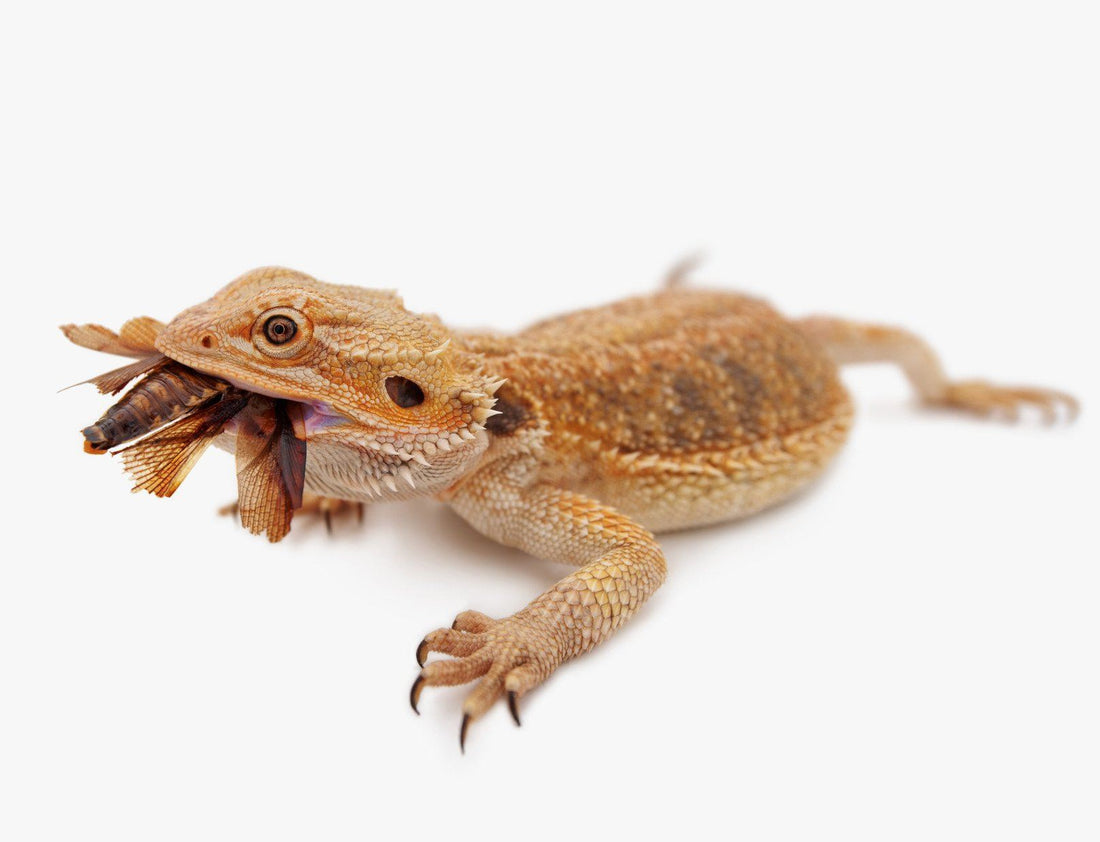If you have an insectivorous or omnivorous pet reptile like a bearded dragon, leopard gecko, chameleon, etc., then you've probably heard of "staple" feeder insects. What does that mean, exactly?
A "staple" feeder is an insect that is nutritious enough to make a regular appearance in your reptile's diet without potentially causing problems like excessive weight gain, organ disease, or other illnesses. Staple feeders also have a reasonable calcium to phosphorus ratio (as close to 2:1 as possible) and must be readily available for regular purchase.
Staple feeder insects are NOT insects that can be exclusively fed to your pet. Regardless of what you may have heard, exclusively feeding just one type of feeder insect for the rest of your reptile's life is a recipe for problems like:
- loss of appetite
- obesity
- vitamin deficiency
- vitamin toxicity
- organ disease
- metabolic bone disease
The key to balanced nutrition for pet reptiles is providing variety in diet. Wild reptiles eat all kinds of different foods in their natural habitat, and their bodies have adapted to thrive under these conditions. Different foods have different kinds and quantities of vitamins, minerals, and macronutrients, so eating a variety of appropriate foods makes your reptile more likely to get the nutrients they need in appropriate amounts.
Plus, consider this: How would you feel if you had to eat the same thing every day? Even if it was your favorite food, and even if it was super nutritious, you'd probably get tired of it pretty fast. Reptiles are often same way.
So here is a list of the best staple feeder insects that you can feed to your pet bearded dragon, leopard gecko, chameleon, etc.
Black Soldier Fly Larvae
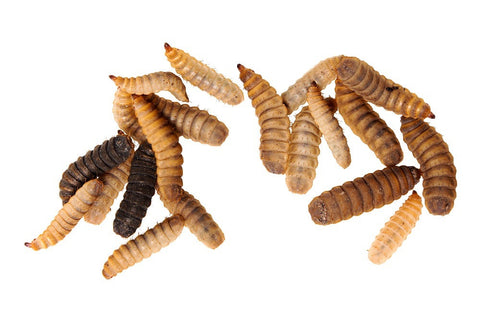
Black soldier fly larvae (also known as "NutriGrubs," among other brand names) are the larval form of the fly, Hermetia illucens. These little worms have become quite popular in recent years, and little wonder — they're easy to store, low-maintenance, and nutritionally well-balanced (although they are higher in fat). However, black soldier fly larvae are most famous for having so much calcium that they don't need to be dusted before feeding!
If you have a reptile that likes to eat flying insects (ex: chameleons), you can grow the larvae into black soldier flies. The flies are also very nutritious, and your reptile will likely enjoy the hunt.
Black Soldier Fly Larvae Nutrition Facts:
- Moisture — 61%
- Protein — 18%
- Fat — 14%
- Ash — 4%
- Fiber — 3%
- Calcium:Phosphorus ratio — 3:1
Crickets
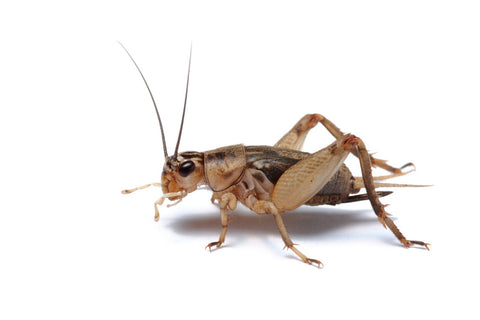
Brown house crickets (Acheta domesticus) have been the #1 most popular feeder insect for reptiles for years. Nutritionally, they have a good amount of protein, are low-fat, and have lots of beneficial amino acids. They are a little low in calcium compared to other feeders, but that's nothing a good calcium-rich gutload can't fix. Plus, while crickets' "skittery" way of moving may creeps humans out, it's very exciting to reptiles!
For some reason, crickets have gained a somewhat negative reputation as feeders in some reptile communities. People claim that crickets are filled with parasites and have no nutrition to offer, but as long as the crickets are raised in hygienic facilities with access to good food (like other feeder insects), then this shouldn't be a problem.
Cricket Nutrition Facts:
- Moisture — 77%
- Protein — 15%
- Fat — 3%
- Ash — 1%
- Fiber — 2%
- Calcium:Phosphorus ratio — 1:9
Discoid Roaches
In some parts of the U.S. (ex: Florida), buying feeders can be tricky because some are potentially invasive species and therefore illegal. Discoid roaches (Blaberus discoidalis) are great because they are usually available where other types of feeder roaches are not. They're similar in nutrition and size to dubia roaches, making them a great alternative.
Even if dubia roaches are legal in your area, discoid roaches are still a great way to add some extra variety to your reptile's diet.
Discoid Roach Nutrition Facts:
- Moisture — 66%
- Protein — 17%
- Fat — 8%
- Ash — 1%
- Fiber — 3%
- Calcium:Phosphorus ratio — 1:3
Dubia Roaches
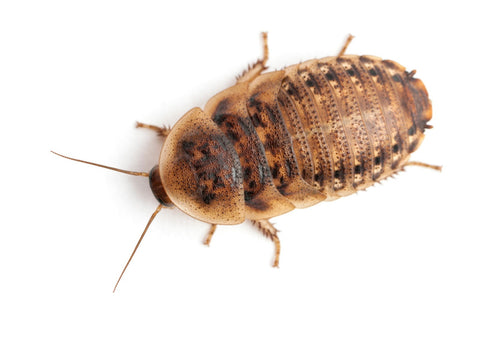
Dubia roaches (Blaptica dubia) are arguably the most popular feeder roach in the U.S. They're rich in nutrients, come in a variety of convenient sizes, and easy to gut-load. One of the reasons why dubia roaches are rapidly becoming more popular than crickets is because they're relatively easier to keep and live longer.
Dubia Roach Nutrition Facts:
- Moisture — 66%
- Protein — 23%
- Fat — 7%
- Ash — 1%
- Fiber — 3%
- Calcium:Phosphorus ratio — 1:3
Hornworms
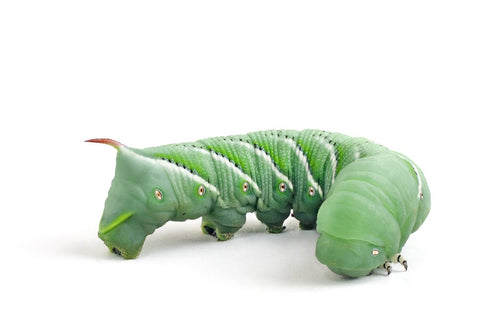
Hornworms are actually the caterpillars of the hawk moth, Manduca sexta. Hornworms are popular to use as feeders, but did you know that they're actually pretty good staple feeder insects, too? Hornworms are easy to care for, easy to digest, and offer balanced nutrition for your reptile.
Plus, if you have a reptile that likes to eat flying insects, such as a larger chameleon, they'd probably enjoy a hawk moth every once in a while. Simply let the hornworms pupate, and soon you'll have hawk moths to use as feeders! Hawk moths are nutritious and great for adding variety to your reptile's diet.
Some say that hornworms shouldn't be used as regular feeders because they can cause a reptile to have diarrhea. This is true if hornworms are feed too often, as they have a very high moisture content. That's why it's important to use a rotation of staple feeders, rather than just sticking to one or two different kinds. Hornworms' high moisture content also makes them great for re-hydrating dehydrated reptiles or helping sick reptiles recover.
Hornworm Nutrition Facts:
- Moisture — 85%
- Protein — 9%
- Fat — 3%
- Calcium:Phosphorus ratio — 1:3
Red Runner Roaches
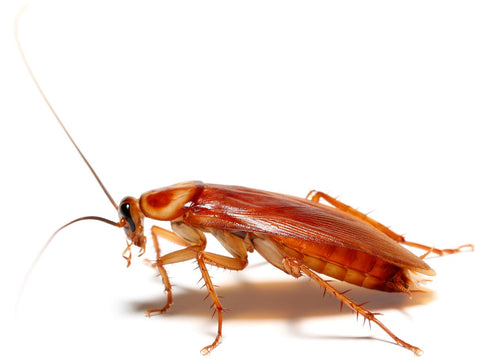
Red runners (Blatta lateralis) are another type of cockroach that make great reptile feeders. They have a rich amino acid profile, balanced nutrition, and best of all, their "skittery" way of moving makes them a great alternative to crickets. This can be a lifesaver if you can't stand the way crickets smell or chirp, or are looking for a low-maintenance feeder that won't die off as fast.
Red Runner Nutrition Facts:
- Moisture — 74%
- Protein — 17%
- Fat — 5%
- Ash — 2%
- Fiber — 2%
Silkworms
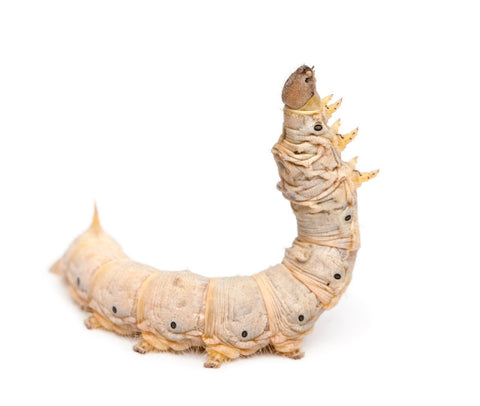
Silkworms are the caterpillars of the domestic silk moth, Bombyx mori. They're best known for their role in making silk fabric, but as it turns out, silkworms are also super nutritious to eat. They're high in protein, low in fat, have a great calcium to phosphorus ratio, and pack a real punch in the moisture department. When cared for properly, a shipment of feeder silkworms can last about a month.
Like hornworms, because of their moisture content, you have to be careful with how often you feed silkworms. However, they're great for re-hydrating dehydration reptiles and helping sick reptiles recover, and are perfectly safe to use as part of a rotation.
Silkworm Nutrition Facts:
- Moisture — 79%
- Protein — 13%
- Fat — 2%
- Ash — 1%
- Fiber — 3%
- Calcium:Phosphorus ratio — 1:2
Creating a healthy feeding schedule for your reptile
Different reptiles need different amounts of food, so using the same feeding schedule for a veiled chameleon and a leopard gecko, for example, isn't going to work. Feeding schedules vary based on factors like size, age, activity level, and whether the reptile in question is an insectivore or an omnivore. It is best to get this information from an expert on the species.
Once you know how often you need to feed your pet reptile, you can start to design a rotation of feeder insects. Aim to have at least three different types of staple feeder insects in your rotation, and more if possible. Here's an example of what one rotation might look like:
Dubia roaches - 40%
Hornworms - 30%
Black soldier fly larvae - 30%
Dubia roaches are high in protein with a moderate amount of fat and moisture. Hornworms are low in protein and fat, but are high in moisture. Black soldier fly larvae have a moderate amount of protein and moisture, but a higher amount of fat. Using these three feeders in a rotation balances the extremes in their nutrition profiles.
Aside from the staples, it's a good idea to throw in some treats like mealworms, superworms, waxworms, and butterworms every once in a while for variety.
The importance of gut-loading
No matter how impressive the above nutrition stats may seem, keep in mind that a feeder insect's nutrition is only as good as the food that it gets. If it has access to plenty of water and nutritious, high-calcium food, then it will be able to offer maximum potential nutrition to your pet. If it doesn't have access to water and has a low-quality diet, then it won't be very nutritious at all.
Some feeder insects, like hornworms, come with all the food they need. Others, like roaches, crickets, and silkworms, will need to be fed by you.
By gut-loading your feeder insects for at least 24 hours before giving them to your pet reptile, you boost their nutritional value and make sure your reptile gets the nutrients they need. A good-quality insect gut-load should 1) meet the insect's specific nutrition needs, 2) be nontoxic to reptiles, and 3) contain additional vitamins, minerals, and calcium. Look for ingredients like alfalfa, spirulina, bee pollen, and calcium carbonate.
Aside from commercially-available insect chows, it's a good idea to also provide fresh vegetables, occasional fruits, and a source of water.
There are many pet reptiles that eat insects as part or all of their diet: anoles, bearded dragons, blue tongue skinks, leopard geckos, African fat-tailed geckos, chameleons, etc. When these reptiles have access to a variety of well gut-loaded feeder insects, they are more likely to be healthier and live longer than those that do not. Shop our selection of live feeders to make sure you have the staple feeder insects to help your pet thrive!
Have questions? Feel free to post them in the comments below and we'll have an expert get back to you as soon as possible.

